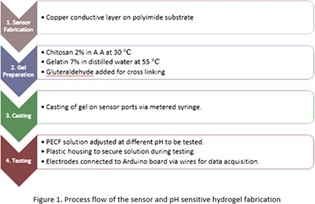
Mariam Mir
National University of Sciences and Technology, Pakistan
Title: Design and fabrication of a hydrogel based ph sensor array for physiological applications
Biography
Biography: Mariam Mir
Abstract
Statement of the Problem: Changes in pH in the physiological environment are an important parameter in assessment of the normal functioning of the body. pH sensors such as pH glass electrodes, fiber optic pH sensors and sensors made from metal oxide have many limitations such as conformance to body contours and single point measurements. To address these limitations, there is a need for a planar, biocompatible and point of care pH sensor array that can conform with body contours and possibly provide a map of pH levels. This study focuses on the design and fabrication of a hydrogel based pH sensor array for physiological applications.
Methodology & Theoretical Orientation: The development of this conductometric pH sensor array has been carried out on the basis of measurement of the conductance of a pH-responsive composite (Chitosan/Gelatin) hydrogel. Since the sensitivity of a hydrogel based conductometric measurements can be dependent upon size and separation of the sensors, both these parameters have been investigated in detail. The design of the pH sensor array is dependent on the electrode density, which is a function of both the optimized size and separation of electrodes. The final electrode density was thus calculated and used for an optimized design of the pH sensor array. For fabrication, copper conductive layer tracts with pH sensitive gel casting, on a polyimide substrate have been used.
Conclusion & Significance: Conductometric tests carried out on the pH sensor array and results show good sensitivity and resolution in the physiological pH range (pH 4 - 10). The pH sensor array may be used for physiological mapping for both in vitro and in vivo measurements.

Recent Publications
1. Chen Y, Mun SC, Kim J. A wide range conductometric pH sensor made with titanium dioxide/multiwall carbon nanotube/cellulose hybrid nanocomposite. Sensors Journal, IEEE. 2013; 13(11):4157- 62.
2. Dhandayuthapani B, Krishnan UM, Sethuraman S. Fabrication and characterization of chitosanâ€gelatin blend nanofibers for skin tissue engineering. Journal of Biomedical Materials Research Part B: Applied Biomaterials. 2010; 94(1):264-72.
3. Vaughan SS, Patel MM. pH-sensitive hydrogels based on semi- interpenetrating network (semi-IPN) of chitosan and polyvinyl pyrrolidone for clarithromycin release. Drug development and industrial pharmacy. 2011; 37(10):1160-9.
4. Berger J, Resist M, Mayer JM, Felt O, Peppas N, Gurny R. Structure and interactions in covalently and ionically crosslinked chitosan hydrogels for biomedical applications. European Journal of Pharmaceutics and Biopharmaceutics. 2004; 57(1):19-34.
5. C. D. Tran and T. M. Mututuvari, ‘‘Cellulose, chitosan, and keratin composite materials. Controlled drug release,’’ Langmuir, vol. 31, no. 4, pp. 1516–1526, 2014.

